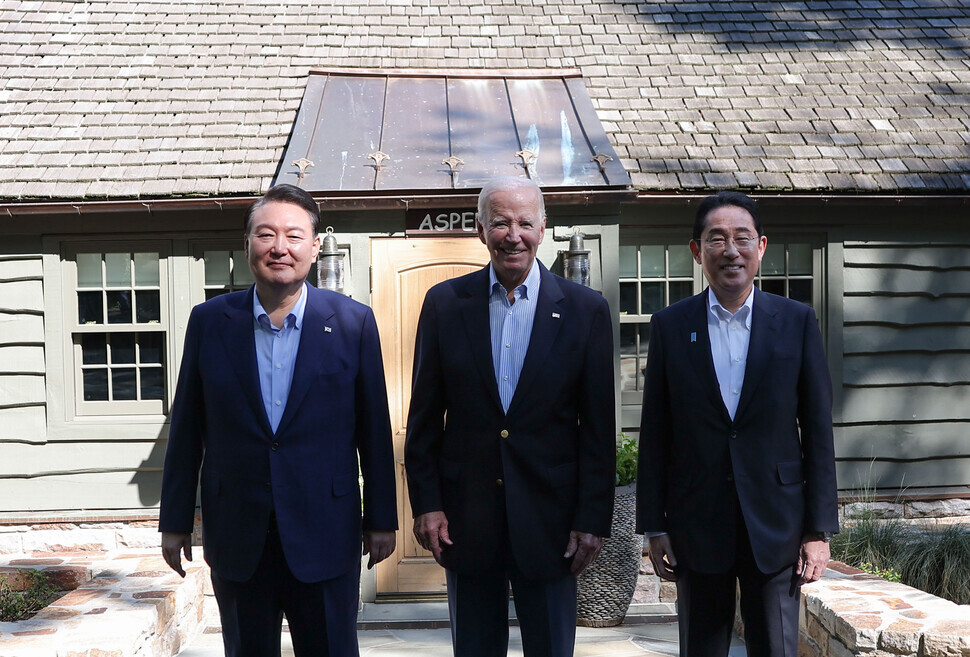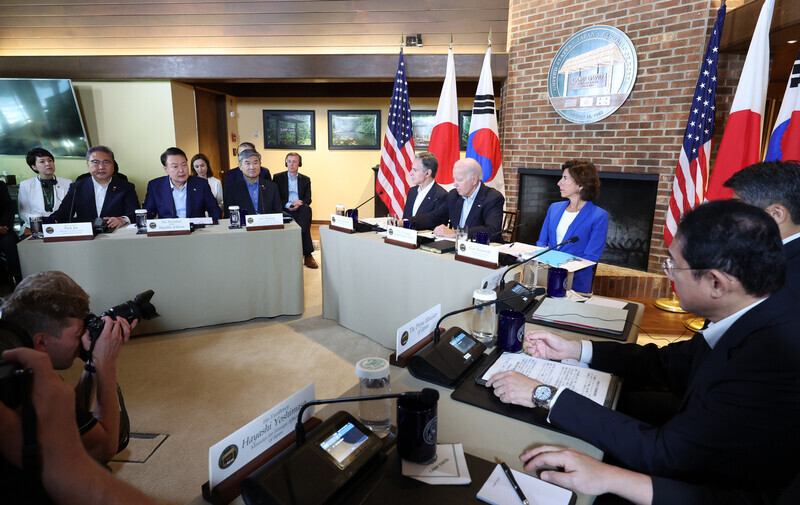hankyoreh
Links to other country sites 다른 나라 사이트 링크
US beefs up supply chain solidarity with S. Korea, Japan with focus on high-tech

The leaders of South Korea, the US, and Japan agreed on a plan for uniting supply chains in the interest of economic security, ranging from advanced industry areas like semiconductors and rechargeable batteries to future industry areas such as artificial intelligence (AI) and space technology.
Major changes appear likely to be in store for the international division of labor that has centered on China as the “world’s production base” over the past three decades.
According to explanations from officials with the South Korean presidential office, including Choi Sang-mok, the senior presidential secretary for economic affairs, the economic cooperation plan agreed upon Friday by the three leaders covers three main areas: establishing supply chain solidarity, cooperating on core future technology, and cooperating toward financial stability.
The first of these, supply chain solidarity, focuses most centrally on establishing frameworks for cooperating on early warning systems among the three sides to respond to procurement difficulties and other risks involving certain core items, including key minerals, semiconductors and rechargeable batteries.
In concrete terms, this means making use of networks among their overseas diplomatic offices and other means to share information on supply chains and cooperate on a joint response if signs of crisis are detected. As a first step, the three sides are poised to begin selecting target items for joint monitoring and diplomatic offices to serve as major bases.

Additionally, coordinated policies on all three sides appear likely to emerge on a broader scope of areas related to the value chain leading from raw materials in key industry areas to equipment and other intermediate goods, as well as the manufacturing of finished products.
The South Korean government also named cooperation on key future technology as a major focus of the agreement. This signifies an expansion of the scope of supply chain solidarity to include future growth industries.
Specifically, the three sides selected AI, space technology, quantum computing, and other fields as core emerging technology targets, where they agreed to cooperate from the early stages on joint research and development, international standardization, and technology protection.
“South Korea, the US, and Japan agreed to continue advancing their cooperation in the areas of economic security and advanced technology that contribute to shared prosperity and growth,” Choi Sang-mok said.
“The US-Japan-ROK economic security dialogue, which was created after the trilateral summit in November of last year, will be a central platform for the three countries’ cooperation on technology,” he added.
The participants in the trilateral dialogue are senior officials with similar positions and duties to those of the South Korean presidential secretary for economic security.
A joint response system is also being developed to deal with the theft of technology by third countries, including China.
“At the US’ suggestion, we’ve agreed to set up a ‘high-tech mobile strike force’ representing each country’s ministries of justice and industry to protect key technologies and prevent their theft,” said Wang Yun-jong, who serves as President Yoon Suk-yeol’s secretary for economic security.
In regard to cooperating on financial stability, the three countries only reached a generic agreement about cooperating in the event of a crisis. The question of whether to hold regular meetings between finance ministers will be subject for discussions on future occasions. Notably, Korea agreed to have its three state-funded banks, including the Export-Import Bank, provide funding to developing countries in the Indo-Pacific region.
The agreements reached at the summit are regarded as an expansion of the US-led strategy of decoupling from China. The economic shock of that strategy may be biggest in Korea, where trade with China accounts for an outsize share of its gross domestic product.
According to figures released by China’s customs authorities, Chinese imports from South Korea were down 6.7% from last year, while Korean exports to China fell by 24.9% during the same period — the highest rate of any of the 23 major countries and regions in the world. In the first half of the year, US exports to China only fell by 5.1%.
That’s why critics object that Korea has more to lose than the US in its containment of China, while having little to gain, either morally or materially.
US Treasury Secretary Janet Yellen, among others, has stressed the strategy of “de-risking,” or gradually reducing the risks posed by China, rather than “decoupling.”
By Kim Mi-na, staff reporter; Park Soon-bin, senior staff writer
Please direct questions or comments to [english@hani.co.kr]

Editorial・opinion
![[Editorial] Intensifying US-China rivalry means Seoul must address uncertainty with Beijing sooner than later [Editorial] Intensifying US-China rivalry means Seoul must address uncertainty with Beijing sooner than later](https://flexible.img.hani.co.kr/flexible/normal/500/300/imgdb/original/2024/0517/8117159322045222.jpg) [Editorial] Intensifying US-China rivalry means Seoul must address uncertainty with Beijing sooner than later
[Editorial] Intensifying US-China rivalry means Seoul must address uncertainty with Beijing sooner than later![[Column] When ‘fairness’ means hate and violence [Column] When ‘fairness’ means hate and violence](https://flexible.img.hani.co.kr/flexible/normal/500/300/imgdb/original/2024/0516/7417158465908824.jpg) [Column] When ‘fairness’ means hate and violence
[Column] When ‘fairness’ means hate and violence- [Editorial] Yoon must stop abusing authority to shield himself from investigation
- [Column] US troop withdrawal from Korea could be the Acheson Line all over
- [Column] How to win back readers who’ve turned to YouTube for news
- [Column] Welcome to the president’s pity party
- [Editorial] Korea must respond firmly to Japan’s attempt to usurp Line
- [Editorial] Transfers of prosecutors investigating Korea’s first lady send chilling message
- [Column] Will Seoul’s ties with Moscow really recover on their own?
- [Column] Samsung’s ‘lost decade’ and Lee Jae-yong’s mismatched chopsticks
Most viewed articles
- 1[Editorial] Transfers of prosecutors investigating Korea’s first lady send chilling message
- 2For new generation of Chinese artists, discontent is disobedience
- 3[Column] US troop withdrawal from Korea could be the Acheson Line all over
- 4[Exclusive] Unearthed memo suggests Gwangju Uprising missing may have been cremated
- 5[Editorial] Intensifying US-China rivalry means Seoul must address uncertainty with Beijing sooner t
- 6Xi, Putin ‘oppose acts of military intimidation’ against N. Korea by US in joint statement
- 7Celine Song says she’s gratified global audiences have responded to the kismet of ‘inyeon’
- 8Could Korea’s Naver lose control of Line to Japan?
- 9China, Russia put foot down on US moves in Asia, ratchet up solidarity with N. Korea
- 10Yoon ridicules critics of Fukushima dumping in first comments since release began